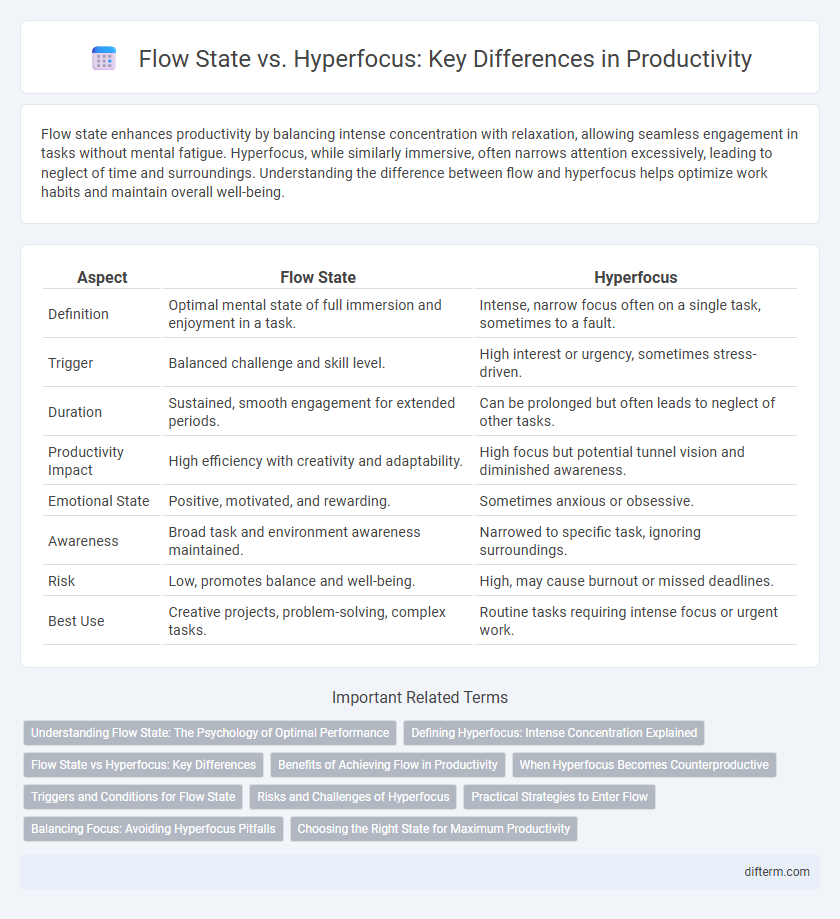Flow state enhances productivity by balancing intense concentration with relaxation, allowing seamless engagement in tasks without mental fatigue. Hyperfocus, while similarly immersive, often narrows attention excessively, leading to neglect of time and surroundings. Understanding the difference between flow and hyperfocus helps optimize work habits and maintain overall well-being.
Table of Comparison
| Aspect | Flow State | Hyperfocus |
|---|---|---|
| Definition | Optimal mental state of full immersion and enjoyment in a task. | Intense, narrow focus often on a single task, sometimes to a fault. |
| Trigger | Balanced challenge and skill level. | High interest or urgency, sometimes stress-driven. |
| Duration | Sustained, smooth engagement for extended periods. | Can be prolonged but often leads to neglect of other tasks. |
| Productivity Impact | High efficiency with creativity and adaptability. | High focus but potential tunnel vision and diminished awareness. |
| Emotional State | Positive, motivated, and rewarding. | Sometimes anxious or obsessive. |
| Awareness | Broad task and environment awareness maintained. | Narrowed to specific task, ignoring surroundings. |
| Risk | Low, promotes balance and well-being. | High, may cause burnout or missed deadlines. |
| Best Use | Creative projects, problem-solving, complex tasks. | Routine tasks requiring intense focus or urgent work. |
Understanding Flow State: The Psychology of Optimal Performance
Flow state, identified by psychologist Mihaly Csikszentmihalyi, represents a mental condition of complete immersion and energized focus, where individuals experience optimal performance and intrinsic motivation. Unlike hyperfocus, which can lead to tunnel vision and difficulty shifting attention, flow balances challenge and skill, promoting creativity, productivity, and sustained engagement. Understanding flow's psychological mechanisms helps optimize work environments and task design to maximize productivity and overall well-being.
Defining Hyperfocus: Intense Concentration Explained
Hyperfocus refers to a state of intense concentration where an individual becomes completely absorbed in a task, often losing track of time and external surroundings. This deep focus can lead to heightened productivity on activities that are personally engaging but may also cause neglect of other responsibilities. Unlike the balanced immersion of flow state, hyperfocus tends to be more rigid and narrowly directed, sometimes resulting in reduced awareness of broader goals.
Flow State vs Hyperfocus: Key Differences
Flow state is a balanced, immersive mental state where an individual experiences heightened creativity and productivity, driven by intrinsic motivation and clear goals. Hyperfocus involves intense concentration on a specific task but can lead to tunnel vision, often disconnecting from broader priorities or external awareness. Understanding these key differences enables better management of attention to optimize work performance and prevent burnout.
Benefits of Achieving Flow in Productivity
Achieving flow state enhances productivity by fostering deep immersion and sustained attention on tasks, leading to higher efficiency and quality output. Flow increases intrinsic motivation and creativity, enabling individuals to solve complex problems more effectively. Unlike hyperfocus, flow balances intense concentration with awareness, preventing burnout and maintaining cognitive flexibility.
When Hyperfocus Becomes Counterproductive
Hyperfocus can become counterproductive when it leads to neglecting other important tasks and disrupts overall productivity balance. Unlike flow state, which maintains a seamless engagement with optimal performance, hyperfocus often causes tunnel vision, making it difficult to switch attention and prioritize effectively. Recognizing the difference helps optimize work strategies and prevent burnout.
Triggers and Conditions for Flow State
Flow state is triggered by a balance between challenge and skill, clear goals, and immediate feedback, creating an immersive productivity experience. Hyperfocus often occurs in response to intense interest or urgency, but lacks the structured conditions that sustain flow. Maintaining optimal conditions such as minimizing distractions and setting specific objectives enhances the likelihood of entering flow and achieving peak performance.
Risks and Challenges of Hyperfocus
Hyperfocus, often mistaken for flow state, can lead to significant risks such as mental exhaustion and neglect of essential tasks outside of the focal point. Unlike flow, which balances challenge and skill with awareness of environment, hyperfocus narrows attention excessively, increasing the likelihood of burnout and decreased productivity over time. Managing hyperfocus requires mindfulness to prevent tunnel vision and ensure a sustainable workflow.
Practical Strategies to Enter Flow
Flow state emerges when engaging in tasks that balance challenge and skill level, fostering deep immersion and creative momentum. Practical strategies to enter flow include minimizing external distractions, setting clear goals, and breaking tasks into manageable chunks to maintain optimal focus. Consistent practice of mindfulness and timed work intervals further enhances the ability to sustain flow and boost productivity.
Balancing Focus: Avoiding Hyperfocus Pitfalls
Balancing focus requires recognizing the difference between flow state and hyperfocus, as flow enhances productivity with sustained concentration and creativity, whereas hyperfocus risks tunnel vision and neglect of broader tasks. To avoid hyperfocus pitfalls, implementing regular breaks and setting clear priorities helps maintain awareness of the overall workflow and prevents burnout. Effective time management tools and mindfulness techniques support transitioning smoothly between tasks, optimizing sustained productivity without losing sight of goals.
Choosing the Right State for Maximum Productivity
Flow state enhances productivity by balancing deep immersion with awareness, enabling sustained creative problem-solving and efficient task completion. Hyperfocus drives intense concentration on specific tasks but may limit adaptability, leading to potential neglect of broader priorities. Selecting the right state depends on task complexity and goal alignment to optimize output while maintaining cognitive flexibility.
Flow state vs Hyperfocus Infographic

 difterm.com
difterm.com